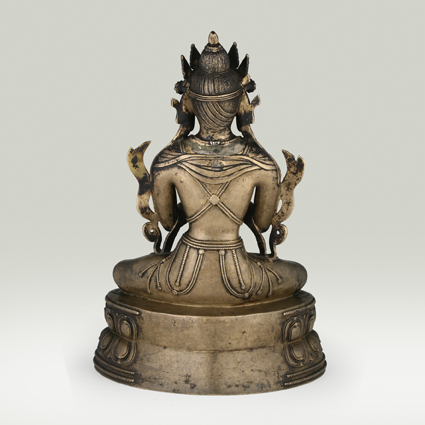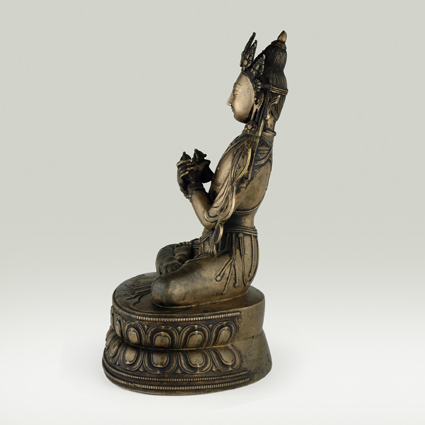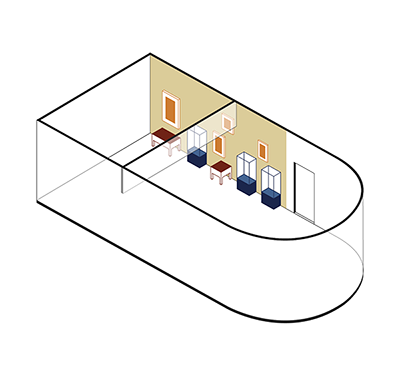ABS 221
Code: ABS 221
Country: Tibet (west)
Style: Tabo
Date: 1450 - 1550
Dimensions in cm WxHxD: 20.8 x 30.5 x 15.2
Materials: Brass
Hollow cast in one piece.
Inset with two turquoise.
Adibuddha Vajradhara, the hands crossed in front of the chest, holds a diamond sceptre (vajra) and a prayer-bell (vajra-gha~†å). The “old translation tradition”(sNga bsgyur) («ngagyur») of the rNying ma («nyingma») order identifies the “Primordial Buddha” with Samantabhadra. The “new translation traditions” (gSar ma pa) («sarmapa») of the bKa’ brgyud («kagyü»), Sa skya («sakya») and dGe lugs («gelug») orders, identify him with Vajradhara or Vajrasattva.
Inset with two turquoise.
Adibuddha Vajradhara, the hands crossed in front of the chest, holds a diamond sceptre (vajra) and a prayer-bell (vajra-gha~†å). The “old translation tradition”(sNga bsgyur) («ngagyur») of the rNying ma («nyingma») order identifies the “Primordial Buddha” with Samantabhadra. The “new translation traditions” (gSar ma pa) («sarmapa») of the bKa’ brgyud («kagyü»), Sa skya («sakya») and dGe lugs («gelug») orders, identify him with Vajradhara or Vajrasattva.
Vajradhara
Vajradhara is the ultimate Primordial Buddha, or Adi Buddha, according to the cosmology of Tibetan Buddhism. Vajradhara displaced Samantabhadra Buddha in Gelug and Kagyu mythologies, but is metaphysically equivalent. Achieving the 'state of vajradhara' is synonymous with complete realisation.
From the primordial Vajradhara/Samantabhadra were manifested the Five Wisdom Buddhas (Dhyani Buddhas):
* Akshobhya
* Amoghasiddhi
* Amitabha
* Ratnasambhava
* Vairocana
Vajradhara and the Widsom Buddhas are often subjects of mandala.
Vajradhara and Samantabhadra are cognate deities with different names, attributes, appearances and iconography. Both are Dharmakaya Buddhas, that is primordial Buddhas, where Samantabhadra is unadorned, that is depicted without any attributes. Conversely, Vajradhara is often adorned and bears attributes, which is generally the iconographic representation of a Sambhogakaya Buddha. Both Vajradhara and Samantabhadra are generally depicted in yab-yum unity and are primordial buddhas, embodying void and ultimate emptiness.
Vajradhara is the ultimate Primordial Buddha, or Adi Buddha, according to the cosmology of Tibetan Buddhism. Vajradhara displaced Samantabhadra Buddha in Gelug and Kagyu mythologies, but is metaphysically equivalent. Achieving the 'state of vajradhara' is synonymous with complete realisation.
From the primordial Vajradhara/Samantabhadra were manifested the Five Wisdom Buddhas (Dhyani Buddhas):
* Akshobhya
* Amoghasiddhi
* Amitabha
* Ratnasambhava
* Vairocana
Vajradhara and the Widsom Buddhas are often subjects of mandala.
Vajradhara and Samantabhadra are cognate deities with different names, attributes, appearances and iconography. Both are Dharmakaya Buddhas, that is primordial Buddhas, where Samantabhadra is unadorned, that is depicted without any attributes. Conversely, Vajradhara is often adorned and bears attributes, which is generally the iconographic representation of a Sambhogakaya Buddha. Both Vajradhara and Samantabhadra are generally depicted in yab-yum unity and are primordial buddhas, embodying void and ultimate emptiness.
Bock, Etienne; Falcombello, Jean-Marc; Jenny Magali, 2022. Trésors du Tibet. Sur les pas de Milarépa.. Paris: Flammarion. p. 86
Sèngué, Tcheuky, 2002. Petite Encyclopédie des Divinités et symboles du Bouddhisme Tibétain. Editions Claire Lumiere . Pp. 106-107 - Références françaises: Vajradhara






